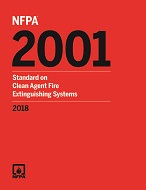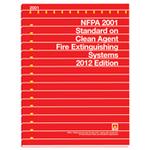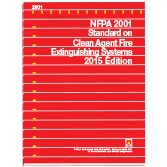
NFPA (Fire) 2001
- Comments Off on NFPA (Fire) 2001
- NFPA-FIRE
Codes and standards published by NFPA are displayed as read-only under license from NFPA solely for use within this system. NFPA material may not be downloaded, printed, reproduced, or transferred.
Get a clearer picture of clean agent systems with the 2022 edition of NFPA 2001, Standard on Clean Agent Fire Extinguishing Systems.
Everyone responsible for fire protection of IT/telecommunications equipment, high-value assets, or marine vessels needs NFPA 2001, Standard on Clean Agent Fire Extinguishing Systems, to keep pace with the latest design and maintenance requirements for the different types of halogenated and inert gas extinguishing agents in use today.
The 2022 edition of NFPA 2001, Standard on Clean Agent Fire Extinguishing Systems, includes essential requirements on how to properly purchase, design, install, test, inspect, approve, operate, and maintain engineered or pre-engineered gaseous agent fire suppression systems so they will function as intended when needed.
Revisions in the 2022 edition of NFPA 2001, Standard on Clean Agent Fire Extinguishing Systems, include several major structural changes and new chapters, including the following:
- Requirements moved from Chapter 1, “Administration”, to Chapter 4, “General Requirements”, to comply with the NFPA Manual of Style
- Information on toxicological and physiological effects of clean agents moved from Annex A to a new stand-alone annex
- System design requirements pertaining only to total flooding systems moved to a new stand-alone chapter and separated from requirements that apply to both total flooding and local application systems
- Requirements for detection, actuation, alarm, and control systems moved to a new stand-alone chapter
- New chapter on system impairment added
- New annex on storage containers for vaporizing-liquid agents added
Several technical updates in the newest edition of the standard include the following:
- New design criteria for 60-bar FK-5-1-12 systems
- New design criteria for halocarbon blend 55 (HB-55) systems
- Clarified terminology and requirements for clean agent design concentrations
- New definition for deep-seated fire
- New information on clean agent purity and the potential toxicity of impurities
- Updated pressure curves for HFC-125
- Updated total flooding quantity tables for inert gas agents
- New requirement to consider potential effects of acoustic noise produced by a clean agent system where noise-sensitive equipment is present
A must have for building or marine vessel owners, installers, maintainers, manufacturers, and authorities having jurisdiction (AHJs).
Order your copy of the reorganized and updated NFPA 2001, Standard on Clean Agent Fire Extinguishing Systems, today to stay up to date on the latest advances in the industry. (Print, 149 pp., 2022)
Product Details
- Published:
- 09/15/2021
- Number of Pages:
- 149



